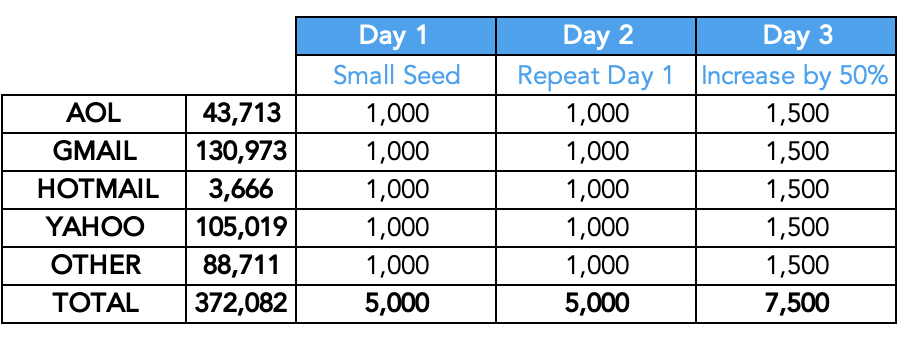When implementing a Marketing Automation Platform, you may find yourself sort of vaguely asked to “warm up the IP.” It’s a nuanced and time-consuming project, but you may not need to do it! This post will hopefully demystify the actual process, and help you understand when you need to warm up an IP.
>> Related: How to Improve Your Email Sender Reputation and Deliverability <<
In this post:
What is IP warming?
IP warming is basically just ramping up volume on your IP. (This refers to the number of individual email addresses receiving an email, not the size of your database, nor the number of email communications you send.)
ISPs really don’t like when you suddenly scale up the size of your emails sends. That’s a classic spammer tactic and a red flag, with harrowing repercussions for your email deliverability rates. It’s not an exaggeration – you could seriously hurt your brand and your domain reputation if you forego a warmup. #ilivedit
Instead, we want to warm up our IP to the new volume in two ways:
- By sending emails to progressively larger lists.
- And by targeting your most engaged audience first, so your first “engagement impression” is your best.
When do I need to warm up my IP?
If you’re significantly increasing your email volume, you want to warm the IP up. There are a lot of reasons you may ramp up your email sizes:
- you acquired a company and its database
- you’re forming a new company
- you’re sending an email to a massive segment for the first time
- you bought a big list (eek)
- you went viral and your database is growing exponentially
- and of course, you’re implementing a new marketing automation platform
What scale of growth looks spammy? I’ve heard “you only need to do this for B2C.” I’ve also heard for “heavy growth,” whatever that is. If your database is 6M and you want to grow 100k, it’s not a big deal. When your database is 15k and you want to grow 100k, you absolutely need to do a warm up. I can’t give you a formula. ¯\_(ツ)_/¯ This is a non-negotiable when you’re dealing with millions, but when in doubt, warm it up. Deliverability problems are painful and slow to recover from – you’re better off preventing them.
Homework before you warm up an IP
Before you kick off your IP warming, please do yourself a favor and scrutinize your SPF, DKIM, and email domains. These are often set up by previous marketers and IT teams. Don’t assume it was done right the first time, and why bother warming up an IP that isn’t configured properly? Similarly, check if you’re on a shared or dedicated IP (the default for Marketo is shared). If you’re on a dedicated IP, you have to be especially cautious.
Also explain this project to the marketing team. IP warm ups can take meaningful time. You should ramp up using your normal cadence (whether that’s daily, semi-weekly, weekly, etc.) It’s fishy to send a barrage of daily emails and then slow down to twice a month. I worked with a client ramping up to a 6M active file… it was a weeks-long process, and it absolutely arrested demand gen (and PR announcements) until it was completed. Give them the context and realistic milestones.
Ask for the email copy and design now. You’re going to send emails to increasingly larger audiences. They have to drive engagement and leave a great brand impression on your new audience. Think of it like dating. If you blow the first couple dates, it’s over. But if you have rapport, and you embarrass yourself on the eighth date, they may give you a second chance. 😘
And decide how you’ll measure success.
- IP warm ups aren’t measured by form fills or even clicks – instead we’re carefully monitoring deliverability and open rates.
- If you’re tracking IP warming across millions of consumer records, it’s worth investing in Everest (formerly ReturnPath) from Validity. Everest will tell you how you’re inboxing across every ISP so you can dial in each one.
- No matter your list size, you can leverage Google Postmaster Tools and free blocklist monitoring tools.
- And you want to pull a fresh scan of your deliverability rate before beginning the warm up. This gives us a baseline to compare to.
How to warm up an IP for B2C
1. Carve up the database by email domain “families”
In B2C, you have to be much stricter about your IP warm up. You’re tangling with Yahoo, Google, and Microsoft! Carving contacts into domain families helps ensure you’re sending the same volume across all of them.

2. Create an IP warmup schedule
Next we want to create a methodical ramp plan that gains speed:
Click to expand
3. Carve contacts into engagement tiers
We will send emails to the most engaged contacts first:
- Usually we start with form fills and clicks
- Then send to “opens”
- And then everyone else
4. Start monitoring every day
Now that you’re warming up, you want to look at your core metrics every day. Open rates, delivery rates, Everest if you have it, Google Postmaster Tools, free blocklist tools, etc. Are you seeing blocks? Are they trending within a certain email client? (Google is usually the most sensitive). If so, pause that segment for a day, or slow down the growth rate.
5. Dial it in
You may notice an ISP is a little more stubborn than another. In my experience Hotmail and Gmail give a lot of weight to engagement and clicks. And Yahoo and AOL care that your list is clean and your domain is reputable. But you’re also not alone! Your marketing automation platform also takes deliverability seriously. I know from experience that Marketo and Salesforce Marketing Cloud have dedicated teams who will absolutely work with you to get it right.
How to warm up an IP for B2B
Warming up an IP for B2B is generally less intense because the volumes are lower and the cadences are slower. We also don’t have the luxury of knowing the ISP – after all, work email addresses are just company names. Instead, you’ll start at Step #2 above, work through your list, follow your normal send schedule, and move from most engaged to least engaged.
It’s okay to need help
If you’re feeling in over your head, its okay. And it’s a lot safer asking for expert help than naively assuming you’ll “figure it out.” I learned this the hard way. My first IP warm up was for a huge company that didn’t mind my inexperience. But I completely botched it and almost ruined their IP! We had to hire an IP warming consultant to come in… and that’s how I learned how to do this properly. When in doubt, explain the project’s risks and get help.
FAQs
What is an SPF?
SPF stands for “Sender Policy Framework,” and it is an email authentication method designed to help prevent email spoofing. SPF is a protocol that enables domain owners to specify which mail servers are authorized to send emails on behalf of their domain.
What is an email domain?
An email domain is the part of an email address that follows the “@” symbol and identifies the mail server associated with the email account. It is a critical component of an email address and helps route emails to the correct destination.
What is a DKIM?
DKIM stands for “DomainKeys Identified Mail,” and it is an email authentication method designed to verify the authenticity of the sender and the integrity of the email content. DKIM helps prevent email spoofing and tampering by allowing the sender to digitally sign their emails with a cryptographic signature.
What is an IP?
IP stands for “Internet Protocol,” and it refers to a set of rules that govern how data is sent and received over the internet.






